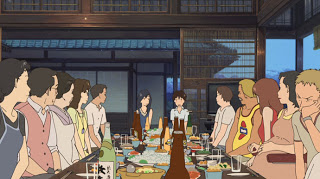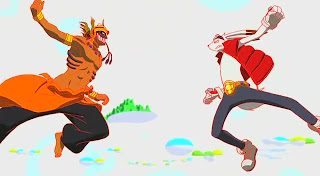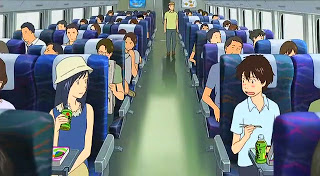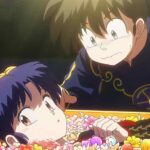For the second time in a week, I had the opportunity to see a film by a young director often hailed as “The next Miyazaki”. Last week it was Makoto Shinkai’s seminal masterpiece 5 Centimeters per Second. This time around, Mamoru Hosoda’s “Summer Wars”.
First if I may, a word or three about this “Young Hayao Miyazaki” nonsense. Anytime I hear someone referred to this way is raises both my hackles and suspicions. I don’t especially want there to be a “next” Miyazaki – I’m quite happy with the one we have. When he retires from directing (as he’s been threatening to do after every film for a decade) that will end the Miyazaki era. And that’s fine – the top young directors don’t want to be the next Miyazaki either – if they did, they wouldn’t be worthy of consideration as heirs to greatness in anime.
That said, I do believe that the two next generation (if you will) directors who have shown the most potential to be artistic giants in Hayao’s class are Shinkai and Hosoda – and especially with the tragic passing of Satoshi Kon at 46, these comparisons are sure to continue. Neither Hosoda or Shinkai reminds me especially of Miyazaki – or each other. Shinkai is an artist of unmatched visual genius in my view. His storytelling tends to be spare and idealistic in tone, wistful and bittersweet and only achieving real grace and subtlety in the superlative “5 CM”. Hosod a, on the other hand, is a more conventional – while still brilliant – visual artist who has distinguished himself as a writer of spectacular creativity and originality. His “The Girl Who Leapt Through Time” was a great success in Japan and even a minor one outside it. It’s been hailed both for its sci-fi accented love story and its starkly defiant portrayal of the teenage heroine. It’s a wonderful film, but for my money Summer Wars achieves a greater level of emotional heft and visual genius.
a, on the other hand, is a more conventional – while still brilliant – visual artist who has distinguished himself as a writer of spectacular creativity and originality. His “The Girl Who Leapt Through Time” was a great success in Japan and even a minor one outside it. It’s been hailed both for its sci-fi accented love story and its starkly defiant portrayal of the teenage heroine. It’s a wonderful film, but for my money Summer Wars achieves a greater level of emotional heft and visual genius.
Summer Wars is really several films in one, as befits its 114 minute running time – quite long for an animated feature. Most of the attention has fallen on the film’s brilliant take on social networking, but before “Oz” takes center stage the film is something equally mesmerizing – a totally engaging portrayal of an old-world Japanese extended family, headed by the stern but loving Granny, Sakae. Kenji is an unassuming, shy math whiz tricked into accompanying Natsumi, the most popular girl in Kenji’s high school, to Sakae’s 90th birthday party at the Jinnoichi estate. The first half hour of the film is mostly an introduction to the odd and wonderful characters that make up this clan, and Kenji’s clumsy attempts to play the part of Natsumi’s fiancee. One thing I’d forgotten is just how funny this film is – Hosoda is a writer of genuine comic genius. The dialogue amongst the family is spot-on, and it’s easy to forget that there’s another story that’s about to play out.
And what a story that is – and one where Hosoda’s seemingly bottomless creativity goes wild. The online community of Oz, in which much of the rest of the film takes place, is one of the great creations of modern cinema. It represents what many of us imagine and hope online communities might someday be – someday soon, even. Yet, it also represents the potential dangers these communities might represent, and not just the conventional ones overzealous parents groups caution us about. While the string of coincidences and technological speculations that drive the rest of the plot do stretch credulity at times, Hosuda’s magic is such that he makes the outlandish seem real, and disbelief is effectively suspended.
Finally, there are a couple of very real human love stories here. The most obvious o ne – between Kenji and Natsumi – is only innocently hinted at, though Sakae has her own views on the subject. There’s also a very moving one between Sakae and Wabisuke, her illegitimate stepson and the black sheep of the family. But the love story at the heart of this film belongs to the entire dysfunctional Jinnouchi family, four generations of them.
ne – between Kenji and Natsumi – is only innocently hinted at, though Sakae has her own views on the subject. There’s also a very moving one between Sakae and Wabisuke, her illegitimate stepson and the black sheep of the family. But the love story at the heart of this film belongs to the entire dysfunctional Jinnouchi family, four generations of them.
Neither Summer Wars or 5 CM, the two finest anime films of the last decade (I would rank both ahead even of “Spirited Away”, Miyazaki’s best film of the period) are reminiscent of Miyazaki. Both stand on their own as bold statements by their talented directors, each of whom is staking their claim as worthy additions to Miyazaki’s perch on the top rung of anime directors. Miyazaki continues to put out fantastic films – I think “Ponyo” will be remembered as one of his better works, though not all agree – and that makes this something of a golden era for theatrical anime in my view. Hosoda is the more “conventional” of the two young lions in style, and he’s in the employ of a major studio, Madhouse. Perhaps it’s the fact that Madhouse has – not entirely wrongly – been tapped as a progeny of Studio Ghibli that he most often receives the “Next Miyazaki” stamp. But while there are direct links between Madhouse and Miyazaki, they’re represented more in the likes of “Mai Mai Miracle” and its director, Sunao Katabuchi, who was the Assistant Director on “Kiki’s Delivery Service”. Hosoda’s work stands as something completely new and different. Yet with his studio connections and more populist style, he stands as more likely than Shinkai to inherit Miyazaki’s spot at the top of the ladder of commercial success. Shinkai is more the lone wolf (quite literally so for the most part with his first two features), the inscrutable artist. Where Hosoda is a master storyteller Shinkai is really more of a poet, both in terms of plot and visuals. Poetry doesn’t sell as well as prose does, no matter how wonderful it is – so one suspects that Shinkai’s role will be the one of critical darling, center of controversy and maverick. Yet both have clearly leapt ahead of all rivals in proclaiming their talents to the world, in my view – only Kenji Kamiyama (“Seirei no Moribito”, “Ghost in the Shell – Stand-alone Complex”) has demonstrated comparable genius, but his best work is more in the realm of television and extended series. Hosoda is just 43, and Shinkai 37 – so it isn’t unrealistic to hope that their creative peaks might still be in their futures. That’s an incredibly exciting thought.
One final note – I’m beginning to wonder if there isn’t a curse on anime screenings in San Francisco. After the self-inflicted debacle at the Crunchyroll “5 CM Per Second” screening that I detailed here last week, there was a glitch with this one too – albeit accidental. The digital projection froze and skipped at the very end of the film, and about a minute of the ending just before the credits was lost. Not the disaster that last week represents, and not intentional – but still irritating, especially under the circumstances.





Kakkou
September 26, 2010 at 8:16 amNot again. It's such a shame for the final moments before the credits of a movie to just get lost like that. This means that those who've never seen SW till then would have missed out on the cute kiss scene at the end and Sakae's laughing portrait, which was such a good little shot to end the movie with =/.
Kakkou
September 26, 2010 at 8:19 amForgot to add, nice write-up. I totally agree with your views on Shinkai and Hosoda.
admin
September 26, 2010 at 10:50 pmThanks. I'm far less upset this time, as it was obviously an accident – whereas the Crunchyroll fiasco was clear premeditated idiocy. Still – why can't they just get it right, for crying out loud?
Shatle
February 28, 2011 at 1:29 amKenji Kamiyama taking Miyazaki's critical/commercial top spot is highly unlikely. That being said though, he's obviously inherented the arguably more respectable intellectual/realism top spot left for him by his mentor Oshii.
admin
February 28, 2011 at 3:42 pmHe needs to listen to the better angels of his nature, though. "Eden of the East" showed what can happen to Kamiyama when he lets his intelligence stray into the realm of pretension. He's at his best when he grounds his work in emotional realism – when it's all about the message there's definitely some loss of emotional impact. Perhaps he's best served adapting rather then creating original works on his own.
Anonymous
April 9, 2011 at 8:36 amIt's Natsuki, not Natsumi, but great review!